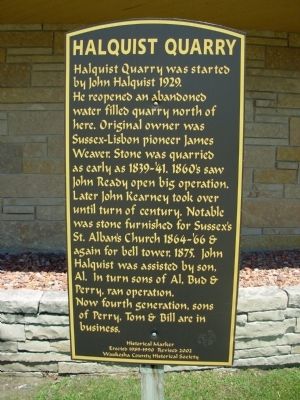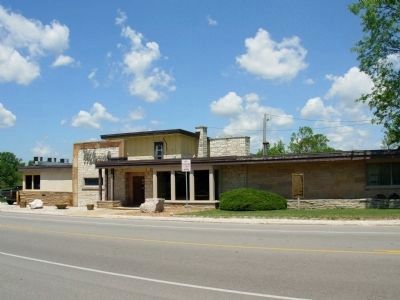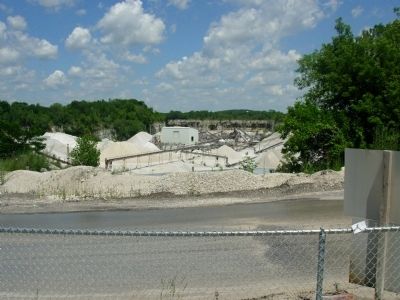Lisbon in Waukesha County, Wisconsin — The American Midwest (Great Lakes)
Halquist Quarry
He reopened an abandoned water filled quarry north of here. Original owner was Sussex-Lisbon pioneer James Weaver. Stone was quarried as early as 1839-'41. 1860's saw John Ready open big operation. Later John Kearney took over until turn of century. Notable was stone furnished for Sussex's St. Alban's church 1864-'66 & again for bell tower, 1875. John Halquist was assisted by son, Al. In turn sons of Al, Bud & Perry, ran operation.
Now fourth generation, sons of Perry, Tom & Bill are in business.
Erected 1989. (Marker Number 13-01.)
Topics. This historical marker is listed in these topic lists: Industry & Commerce • Natural Resources • Notable Places. A significant historical year for this entry is 1929.
Location. 43° 6.724′ N, 88° 12.932′ W. Marker is in Lisbon, Wisconsin, in Waukesha County. Marker is on Lisbon Road, ¼ mile west of Wisconsin Highway 74, on the right when traveling west. Touch for map. Marker is at or near this postal address: W23560 Lisbon Road (Hwy K), Sussex WI 53089, United States of America. Touch for directions.
Other nearby markers. At least 8 other markers are within 3 miles of this marker, measured as the crow flies. Hon. Thomas Weaver Home (approx. 0.4 miles away); Sussex Mills and Bug Line RR (approx. 1½ miles away); Mammoth Spring Hotel - Saloon (approx. 1½ miles away); George Washington Burr Oak (approx. 1.6 miles away); First Woman in Town of Lisbon (approx. 1.6 miles away); St. Alban’s Episcopal Church (approx. 1.6 miles away); Zion Evangelical Cemetery (approx. 1.9 miles away); Pioneer St. James Catholic Church (approx. 2.3 miles away).
Related marker. Click here for another marker that is related to this marker. To better understand the relationship, study each marker in the order shown.
Additional commentary.
1. History of Halquist Quarry
The original owner of the Halquist Quarry land was Sussex-Lisbon pioneer James Weaver. A grant was presented to him by Gov. Henry Dodge. Stone was quarried as early as 1839-41. The 1860s saw John Ready open a larger operation. Later John Kerney took over until the turn of the century. Notable in the earlier days of the quarry, stone was furnished for Sussex's St. Alban's Church in 1864-66 and again for the bell tower in 1875. Milwaukee's Haymarket Square was paved with it. The quarry was closed in 1898 and not reopened until 1929 due to the fact that streets were no longer paved with the stone.
John Halquist began the Halquist Stone Company in 1929 with his son Al. Halquist came here from Malmow, Sweden in 1903 where as a boy he learned the stonecutter trade. They originally produced curb stone, paving block, and stone for local barns, basements, and homes. Later they produced building stone and landscaping stone. During this time, cutting was done entirely with hand tools and quarrying with pick and bar.
In 1937, a crushing plant was built producing crushed stone and agricultural limestone. During WWII only the crushing plant was in operation. Men during these years were from many nations, and they worked at the quarry bringing their special cutting tools with them including reels, side hammers, tifflers, and pitching tools.
It was very popular to build houses from Lannon stone in the 1930s and 1940s. Many neighborhoods in Milwaukee and Waukesha contain homes built of Lannon stone. Two other quarries were purchased by Halquist; on Good Hope Road in Lannon and on Town Line Road in Menomonee Falls. They are often called on to match existing stone on homes when people remodel. Many large buildings in Milwaukee were built using Halquist stone including Brookfield Square, Milwaukee's main post office, Mayfair shopping center, the Miwuakee Zoo, and the Milwaukee County Museum. This stone which has suvived millennia still carries with it the impressions of various fossils. The hardness of the stone and the bluish white to orange color differentiates it from other stone.
After John Halquist and son Al retired, sons of Al; Bud and Perry ran the operation. Now the fourth generation, sons of Perry; Tom and Bill continue the tradition.
— Submitted June 15, 2011, by Linda Hansen of Waukesha, Wisconsin.
Credits. This page was last revised on December 6, 2020. It was originally submitted on July 13, 2010, by Paul Fehrenbach of Germantown, Wisconsin. This page has been viewed 1,738 times since then and 61 times this year. Last updated on June 20, 2011, by Paul Fehrenbach of Germantown, Wisconsin. Photos: 1, 2, 3. submitted on July 13, 2010, by Paul Fehrenbach of Germantown, Wisconsin. • Kevin W. was the editor who published this page.


